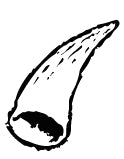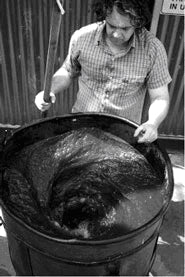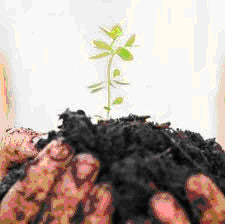A Biodynamic Wine is, by definition, also Organic. In addition to the rigourous standards that Organic Wines must adhere to, Biodynamic Wines must also follow additional standards laid down by the Demeter Association, the internationally recognized certifying body for biodynamic products.
Biodynamics pre-dates organic farming by half a century and is based on a series of lectures given by Rudolf Steiner in the 1920’s. This system of agriculture shuns chemical inputs in the same way that other organic farmers do. In addition, it incorporates lunar and cosmic rhythms into the timing of the application of special biodynamic preparations designed to benefit both soil and plants. In France, some prestigious estates such as Chateau Margaux and Domaine de la Romainée-Conti are managed biodynamically as are scores of other less well known wine estates. The system is currently enjoying something of a renaissance around the globe, especially among wine growers, as a number of formerly organic vineyards are upgrading to this ‘gold standard’ organic system.

The Demeter Biodynamic Logo
“To our modern way of thinking, this all sounds quite insane” - Rudolf Steiner, Agriculture, 1924
In recent years there has been an explosion of interest in organic and biodynamic produce. Although once marginal and `alternative', escalating concerns about the environment, health, food quality and animal welfare have brought organics into mainstream consciousness.

Photo: Max Allen
Biodynamics, a unique development of the organic approach, does not narrowly focus on agricultural techniques. It was conceived as a new way of thinking about farming, nutrition and the world of nature, allowing for a revitalized relationship with the living soil, the elemental world and the cosmos.
On his website exploring Biodynamics in vineyards - http://www.redwhiteandgreen.com.au/ - Australian wine writer Max Allen provides a background to this unique form of organic agriculture. His explanation is reproduced here with permission:
In 1924 the Austrian philosopher Rudolf Steiner gave a series of lectures outlining a new approach to agriculture to a group of farmers concerned about the dwindling fertility of their crops and declining health of their livestock.
The directions Steiner gave in these lectures became the foundations of what we know today as the biodynamic system of organic farming. In some ways, he was ahead of his time: not only can Steiner's lectures be seen as possibly the world's first systematic attempt to develop an organic farming system in response to the encroaching power of the industrial agricultural movement, but his repeated observations throughout the lectures that "everything in nature is interdependent" also predates James Lovelock's Gaia theory by half a century.
A number of people - including Maria Thun in Germany, Alex Podolinsky in Australia and Peter Proctor in New Zealand - took Steiner's initial ideas and developed them over the ensuing decades. Today, biodynamics is a complex toolkit of philosophies and techniques available to anybody interested in farming - or growing grapes and making wine - sustainably.

Illustration: Max Allen, taken from http://www.redwhiteandgreen.com.au/
Steiner was the founder and figurehead of the Anthroposophical Society, a movement dedicated to bridging the gap between the physical and spiritual worlds. He called his 1924 lectures "Spiritual Foundations for the Renewal of Agriculture" (usually known simply as "Agriculture") which is important to note because the methods Steiner proposed were practical, energetic and spiritual. Practical in that they were intended to increase microbial life, structure and nutrient availability in the soil; energetic in that they were intended to synchronise the earth with the influences of the moon and planets; and spiritual in that an anthroposophical approach to agriculture would, he hoped, encourage humans to connect to the spirit world.
THE BIODYNAMIC PREPARATIONS
Preparation 500
The cornerstone of biodynamics is preparation 500. This is made by stuffing cow manure into cow horns, burying those horns over winter, then stirring a small amount of the fermented manure in rain water (Proctor recommends 25 grams of 500 in 13 litres of water for a one acre block) for an hour and spraying the resulting liquid in droplets on your vineyard soil. The details of the stirring are important: it has to be for an hour, using the reverse vortex method, where the water is stirred in one direction until a vortex forms in the bucket - and then when the vortex reaches the bottom, the stirring direction is reversed, creating chaos in the liquid. Again, this works on many levels, depending on who you talk to: this is either a way of attracting cosmic influences into the liquid - or just a bloody good way of mixing stuff up. 500 is used to improve soil structure and microbiological activity.

Photo: Cape Jaffa Wines
Preparation 501
This is made by stuffing finely-ground quartz (silica) into cow horns, burying those horns over summer, then stirring a very small amount (just a couple of grams) of the powder in rain water for an hour and spraying the resulting liquid in a fine mist over your vines. The purpose of 501 is to complement the earthy forces of the 500 and attract light forces to the plant. Preparations 502-507
Tiny amounts - teaspoonfuls - of these preps are added to the compost to bring various benefits to the resulting humus when added to the soil. They can also be added to compost tea.
502 - Yarrow flowers matured in a stag's bladder, hung up in a tree over summer; said to attract light forces and connect the soil to cosmic influences.
503 - Chamomile flowers stuffed into cow's intestines and buried over winter; said to help the breakdown of the compost.
504 - Stinging nettle buried for a year; said to bring intelligence to the soil.
505 - Oak bark buried in a sheep skull in a damp place over winter; helps attract earth forces to the soil.
506 - Dandelion flowers buried over winter in a cow's mesentery; said to bring life forces to the soil and the plants which grow in it.
507 - A solution of valerian flowers, sprayed over the compost heap; said to bring warmth to the compost.
Preparation 508
This is a solution of equisetum - horsetail - heavily diluted and sprayed on vines to bring a drying effect. Useful in a damp season, helpful in countering mould.
OTHER BIODYNAMIC PRACTICES
Composting
"Composting's my passion", says Barry Morey of Sorrenberg vineyard in Beechworth, as he digs into a beautiful pile of sweet black goodness. He's not alone: good compost - with preps 500-507 added - spread under the vines and between the rows is a crucial part of building structure and microbial activity in biodynamic soil. Many BD growers also make cow pat pit, or CPP - otherwise known as barrel compost or manure concentrate. This is a barrow-load of cow manure, mixed with crushed eggshells, basalt dust and the compost preps, then matured for six weeks, either in a shallow pit or in a half-buried barrel (hence the name). This is then stirred in with the 500 and sprayed onto the soil.
Following the phases of the moon and positions of the planets
Steiner wasn't the first person to encourage awareness of the position of the moon and stars when farming. Indeed, he described such awareness as peasant wisdom - something which had been lost in his/our materialistic age, and which his farming methods aimed to recapture.
The effect of the moon is easy to understand. As Jane Sandilands of Haywards of Locksley vineyard in the Strathbogie Ranges puts it: "If you can grasp the concept of the moon affecting the tides, you should be able to extend that to vines. You can see it for yourself at pruning times: you can see the differences in the sap flow depending on the phases of the moon."
It kind of makes sense, then, that 500, for example - with all its supposed earthy influences - should be sprayed in the afternoon under a descending, waning moon.
It's perhaps harder to grasp, though, that the moon's relative position to distant constellations or planets might also have an effect on what happens on earth. But many biodynamic winegrowers soon do grasp this concept, and follow their Astro Calendar as closely as they can, timing their activities according to whether it's a fruit day (moon in a fire sign such as Leo - good for picking grapes), root day (moon in an earth sign such as Taurus - good for making compost, spraying 500), leaf day (water sign, Scorpio) or flower day (air, Aquarius). Most also avoid agricultural activity (or activity of any kind) during disruptive times, when the moon's path crosses the path of the sun.
Some people also extend this idea to tasting wine, believing that fruit days will best display the wine's varietal character and quality - and that root days are to be avoided because the wines will be least expressive. And as for tasting on a node day - well, just forget about it.
(For more information on biodynamics in vineyards, visit wine writer Max Allen's website http://www.redwhiteandgreen.com.au/ )
BIODYNAMICS AND THE FUTURE
If biodynamics is such a good thing, why hasn´t it swept the planet?
I think there are two reasons. First of all, it requires a little time and effort to get to grips with the principles involved, to understand what needs to be done on the land in order to make biodynamics work for you. It certainly doesn't offer the quick fix of a box of synthetic fertilizers. It takes time, which is something that we generally think we´re so short of.
Secondly, there´s not much of an opportunity to make megabucks through supplying farmers with biodynamic products.

